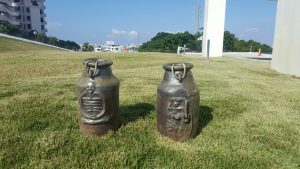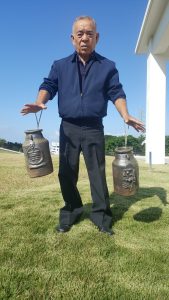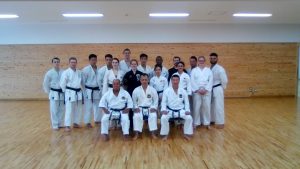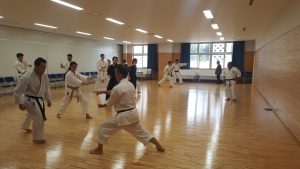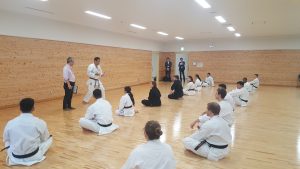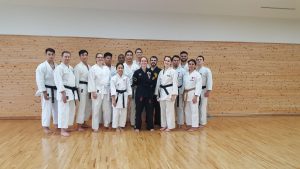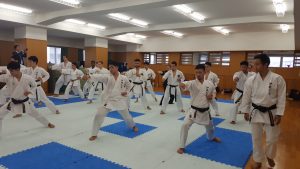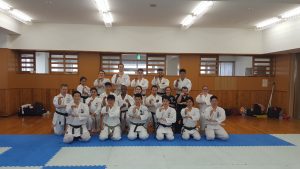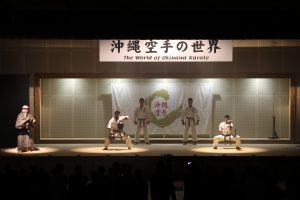Practitioners of Okinawa karate use various daily utensils in their training regimen to condition their body. Among them are what is called Nigiri-gāmi or Sanchin-gāmi. These jug of various shapes and weight are found in many Okinawa karate dōjō, particularly in Gōjū-ryū and Uechi-ryū. Traditionally, practitioners add a little more water or sand every day to weigh down the jugs, thus developing gripping power, among other skills.
Ideally, the mouth of the jugs would be mold to fit the hands of the person to use it. While this tradition tends to disappear, the outside design of the jug is something people care for, as the jugs are part of a dōjō, serving both a practical and an esthetic purposes.
Gushiken Zenshin (photo below) is a ceramics master from Katsuren, Uruma City. In Okinawan language, Katsuren is said Kacchin, thus the name of his kiln Kacchin-gama or Katsuren Kiln. After making earthenware pots, jugs and other common pottery artifacts all his life, Mr. Gushiken had the brilliant idea to combine his skills with the needs of karate.
He designed and created gripping jars with various beautiful designs of Daruma – Bodhidharma, founder of China Zen sect and the Buddha who became bones and skin after severe yoga practice. As explains Gushiken Zenshin, “Both are symbols of fearless asceticism”.
Next to beauty, another characteristic makes his jars special: each of the jug is inserted with a rope to prevent the beautiful but delicate jug from falling when being gripped.
For the 5th time, Gushiken Zenshin will be exhibiting his artwork at the Seisa Gallery, 3-17-5 1F Kumoji, Naha City February 6th~18th.
Furthermore, the special feature of these karate jars having been registered, these corded grip jars should soon be available at the Okinawa Karate Kaikan’s shop.
We have updates the list of events scheduled in Okinawa for February and March 2018.
Following the organization of a program for 20 students from Cambodia November 16th - 20th, the Okinawa Karate Information Center was requested to plan and implement a three day karate program in Okinawa for 15 American college students.
This project entitled "Kakehashi Project" was hosted by the Ministry of Foreign Affairs and was conducted by the Japan International Cooperation Center (JICE) Kyushu Branch.
Participants were students of 15 universities and educational institutions in the United States, from places such as Washington, Alaska, California, Massachusetts, etc. They also are students of various karate styles like Shōtōkan, Shitō-ryū, Wadō-ryū, Kenpō, Gōjū-ryū, Ryūei-ryū, Shaolin Kenpō and Shōrin-ryū. Among them were high level athletes like Brian Irr and Cesar Colunga from the US national team.
Of a 22 years old age average, the group visited the Okinawa Karate Kaikan on January 18th. After listening to a lecture by OKIC Uehara Kunio, the trainees watched a demonstration that occurred on the same day at the Kaikan.
Discovering the essence of Okinawa traditional karate being one of the purposes of their visit, the party trained on the morning of 19th with Muramatsu Masataka, Takara Seigō and Hirata Seiei, instructors at the Okinawa Gōjū-ryū Karatedō Association. They experienced the unique training method of Nahate and the kata Fukyū gata II, etc.
After lunch and the visit of the Kaikan’s Archives, the US students joined a seminar on Shurite taught by Uema Takeshi of the Shubukan Uema Karate Dōjō. After being explained the difference between Nahate and Shurite, they learned the kata Naihanchi, and Fukyū gata I, practicing various exercises.
Fukyū gata I and II were devised in 1941 by Masters Nagamine Shōshin and Miyagi Chōjun, who were appointed by Hayakawa Hajime, Governor of Okinawa at that time. The kata were meant to spread and develop Karate, thus the name fukyū or diffusion. The first one includes the basic technique of Shurite while the second one is a combination of basic Nahate and Gōjū-ryū techniques.
During the 3 day schedule, an exchange with local college karate students was also planned. On the third day, January 20th, the group visited the campus of Okinawa University for a practice session with the members of the said university karate club joined by Okinawa International University karateka. Over 2 hours, under the guidance of Ikemiyagi Taku and Shimoji Eisaku, everyone enjoyed sweating together while deepening friendship.
After experiencing a night in private houses in the southern part of the main island of Okinawa, the US team returned to Tōkyō on the 22nd, visited the All Japan Karatedō Federation for a lecture and returned home.
“The World of Okinawa Karate” sample demonstration that promotes Okinawa as the birthplace of karate was held on Thursday, January 18th. On that day, more than 70 people from 25 tourism related companies gathered at the Okinawa Karate Kaikan. The event was organized by the Okinawa Prefectural Karate Promotion Division, ODKS which is responsible for the operation of our center and OCVB.
Planned for general tourists and school trip excursion students, this stage conveys the technique and essence of Okinawa karate for about 20 minutes.
For inquiries, please contact our center.
More information will be posted at a later date.
The Okinawa Prefecture Karate promotion division is organizing 2 symposiums in relation with the Okinawa Karate Promotion Vision draw up project.
Date: January 20th, 2018 12:30-14:00
Site: Miyakojima City Central public Hall (Miyakojima shi cyuo kominkan)
Entrance: Free
Date: January 21st, 2018 16:00-17:30
Site: Ishigaki City Health and welwafe center (Ishigaki shi kenko fukushi center)
Entrance: Free
(Unfortunately, the symposiums will be in Japanese only)
For more, check out the Japanese page.
